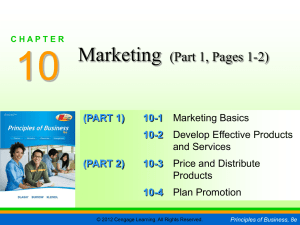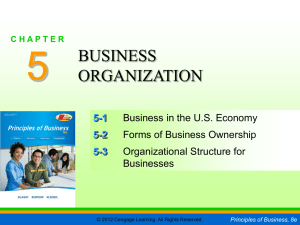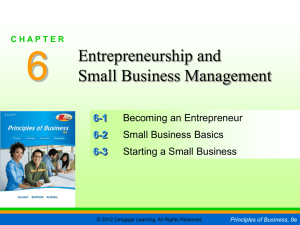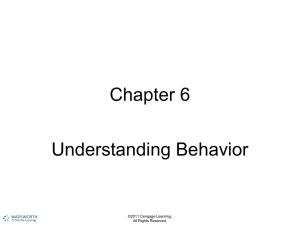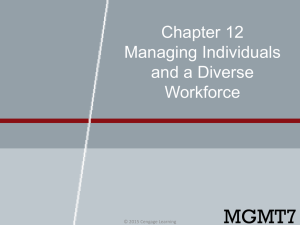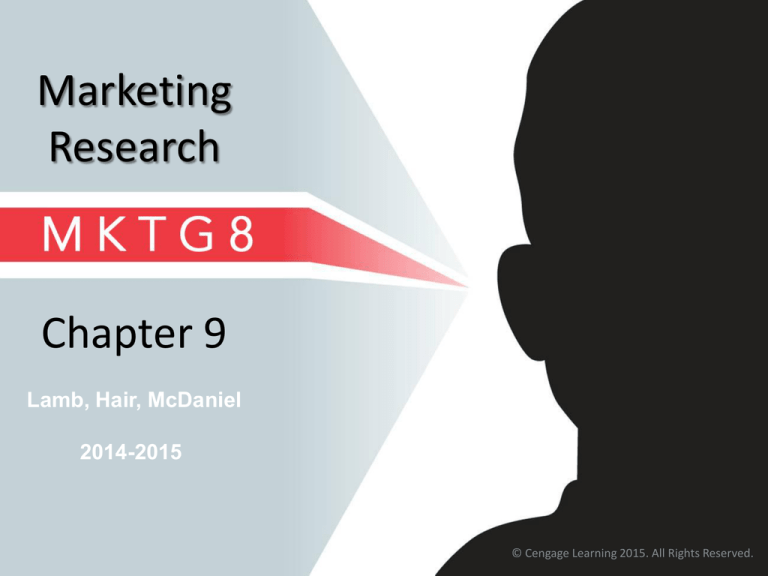
Marketing
Research
Chapter 9
Lamb, Hair, McDaniel
2014-2015
© Cengage Learning 2015. All Rights Reserved.
1
Define marketing research and explain
its importance to marketing decision
making
2
Describe the steps involved in
conducting a marketing research
project
3
Discuss the profound impact of the
Internet on marketing research
© Cengage Learning Inc. 2015. All Rights Reserved.
2
4
Discuss the growing importance of scannerbased research
5
Explain when marketing research should be
conducted
6
Explain the concept of competitive
intelligence
© Cengage Learning Inc. 2015. All Rights Reserved.
3
The Role of
Marketing Research
Define marketing research
and explain its importance
to marketing decision
making
1
4
© Cengage Learning Inc. 2015. All Rights Reserved.
The Role of
Marketing Research
Marketing research is the process of
planning, collecting, and analyzing
data relevant to a marketing
decision.
1
© Cengage Learning Inc. 2015. All Rights Reserved.
5
The Role of
Marketing Research
Descriptive
Gathering and presenting
factual statements
Diagnostic
Explaining data
Predictive
Addressing “what if”
questions
1
© Cengage Learning Inc. 2015. All Rights Reserved.
6
Management Uses of
Marketing Research
Marketing research can help
managers in several ways:
•
•
•
•
It improves the quality of decision
making
It helps managers trace problems
It can help managers serve their
customers accurately and efficiently
It helps managers gauge the perceived
value of their goods and services, as
well as the level of customer satisfaction
1
© Cengage Learning Inc. 2015. All Rights Reserved.
7
Management Uses of Marketing Research
Improve the quality of decision
making
Trace problems
Focus on keeping existing customers
Understand the marketplace
Alert them to marketplace
trends
Gauge the value of goods
and services, and the level
of customer satisfaction
8
© Cengage Learning Inc. 2015. All Rights Reserved.
Steps in a Marketing
Research Project
Describe the
steps involved
in conducting
a marketing
research project
2
9
© Cengage Learning Inc. 2015. All Rights Reserved.
1
Exhibit 9.1
The Marketing Research
Process
Define
Problem
2
Plan Design/
Primary Data
3 Specify
Sampling
Procedure
4
Collect
Data
5 Analyze
6 Prepare/
Data
Present
Report
7
Follow Up
© Cengage Learning Inc. 2015. All Rights Reserved.
10
The Marketing Research
Project
Marketing
Research
Problem
Determining what information is needed
and how that information can be
obtained efficiently and effectively.
Marketing
Research
Objective
The specific information needed to solve
a marketing research problem; the
objective should be to provide insightful
decision-making information.
Management
Decision
Problem
A broad-based problem that uses
marketing research in order for
managers to take proper actions.
2
© Cengage Learning Inc. 2015. All Rights Reserved.
11
Sources of
Secondary Data
Internal Corporate Information
Government Agencies
Trade and Industry Associations
Business Periodicals
News Media
2
© Cengage Learning Inc. 2015. All Rights Reserved.
12
Advantages of
Secondary Data
Saves time and money if on
target
Aids in determining direction for
primary data collection
Pinpoints the kinds of people to
approach
Serves as a basis of comparison
for other data
2
© Cengage Learning Inc. 2015. All Rights Reserved.
13
Disadvantages of
Secondary Data
May not give adequate
detailed information
May not be on target with
the research problem
Quality and accuracy of data
may pose a problem
2
© Cengage Learning Inc. 2015. All Rights Reserved.
14
The New Age of Secondary
Information: The Internet
The rapid development of the
Internet has eliminated much of
the drudgery associated with the
collection of secondary data.
2
© Cengage Learning Inc. 2015. All Rights Reserved.
15
Planning the Research Design
Which research
questions
must be answered?
?
How and when
will data be
gathered?
How will
the data
be analyzed?
2
16
© Cengage Learning Inc. 2015. All Rights Reserved.
Primary Data
Information collected for the first time.
Used for solving the particular problem under
investigation.
Advantages:
Answers a specific research question
Data are current
Source of data is known
Secrecy can be maintained
2
© Cengage Learning Inc. 2015. All Rights Reserved.
17
Disadvantages of
Primary Data
Primary data can be very
expensive.
Disadvantages are usually offset
by the advantages of primary
data.
2
© Cengage Learning Inc. 2015. All Rights Reserved.
18
Survey Research
The most popular technique for
gathering primary data, in which
a researcher interacts with
people to obtain facts, opinions,
and attitudes.
2
© Cengage Learning Inc. 2015. All Rights Reserved.
19
Forms of Survey Research
In-Home Interviews
Mall Intercept Interviews
Telephone Interviews
Mail Surveys
Executive Interviews
2
Focus Groups
20
© Cengage Learning Inc. 2015. All Rights Reserved.
Questionnaire Design
Open-Ended
Question
An interview question that
encourages an answer phrased in
the respondent’s own words.
An interview question that asks
Closed-Ended
the respondent to make a selection
Question
from a limited list of responses.
ScaledResponse
Question
A closed-ended question
designed to measure the intensity
of a respondent’s answer.
2
© Cengage Learning Inc. 2015. All Rights Reserved.
21
Questionnaire Design
Clear and concise
No ambiguous language
Avoid leading questions
Avoid two questions in one
2
© Cengage Learning Inc. 2015. All Rights Reserved.
22
Observation Research
A research method that relies on
four types of observation:
People watching people
People watching an activity
Machines watching people
Machines watching an activity
2
© Cengage Learning Inc. 2015. All Rights Reserved.
23
Exhibit 9.4
Observational Situations
Situation
Example
People watching people
Observers stationed in supermarkets
watch consumers select frozen
Mexican dinners; the purpose is to
see how much comparison shopping
people do at the point of purchase.
People watching phenomena
Observer stationed at an intersection
counts traffic moving in various
directions.
Machines watching people
Movie or videotape cameras record
behavior as in the people-watchingpeople example above.
Machines watching phenomena
Traffic counting machines monitor
traffic flow.
© Cengage Learning Inc. 2015. All Rights Reserved.
24
Observational Research
Mystery
Shoppers
Researchers posing as customers
who gather observational data about
a store.
Behavioral
Targeting
(BT)
A form of observation marketing
research that uses data mining
coupled with identifying Web surfers
by the IP addresses.
2
© Cengage Learning Inc. 2015. All Rights Reserved.
25
Social Media and Big Data
Through social media monitoring,
a researcher can learn what is
being said about the brand and
the competition.
Monitoring social media and
tracking shopping behavior
online are only two inputs into
the new era of big data.
2
© Cengage Learning Inc. 2015. All Rights Reserved.
26
Ethnographic Research
The study of human behavior in
its natural context; involves
observation of behavior and
physical setting.
2
© Cengage Learning Inc. 2015. All Rights Reserved.
27
Virtual Shopping
Advantages of virtual shopping:
• Creates an environment with a
realistic level of complexity and
variety.
• Allows quick set up and altering of
tests.
• Low production costs.
• High flexibility.
2
© Cengage Learning Inc. 2015. All Rights Reserved.
28
Experiments
Experiments are used by researchers
to gather primary data.
Experiment Variables
Price
Package design
Shelf space
Advertising theme
Advertising expenditures
2
© Cengage Learning Inc. 2015. All Rights Reserved.
29
Mobile Research
Mobile devices and laptops are being used
for all kinds of marketing research. A few
techniques that are now employed using
mobile devices are:
• Location-based surveys
• Product scanning during the shopping process
• Using cameras on mobile devices to upload
digital images and videos
2
© Cengage Learning Inc. 2015. All Rights Reserved.
30
Sampling Procedure
Universe
Sample
Probability
Samples
2
Non-Probability
Samples
© Cengage Learning Inc. 2015. All Rights Reserved.
31
Types of Samples
Probability
Samples
Non-Probability
Samples
Simple Random
Sample
Convenience
Sample
Stratified
Sample
Judgment
Sample
Cluster
Sample
Quota
Sample
Systematic
Sample
Snowball
Sample
2
© Cengage Learning Inc. 2015. All Rights Reserved.
32
Probability Samples
Probability
Sample
A sample in which every element
in the population has a known
statistical likelihood of being
selected.
Random
Sample
A sample arranged so that every
element of the population has an
equal chance of being selected.
2
© Cengage Learning Inc. 2015. All Rights Reserved.
33
Nonprobability Samples
Nonprobability
Sample
Any sample in which little or
no attempt is made to get a
representative cross-section of the
population.
Convenience
Sample
A form of nonprobability sample
using respondents who are
convenient or readily
accessible to the researcher.
2
© Cengage Learning Inc. 2015. All Rights Reserved.
34
Types of Errors
Measurement
Error
Error when there is a difference
between the information desired and
the information provided by the
process
Sampling
Error
Error when a sample somehow does
not represent the target population.
Frame
Error
Error when a sample drawn from a
population differs from the
target population.
Random
Error
Error because the selected sample is
an imperfect representation of
the overall population.
2
© Cengage Learning Inc. 2015. All Rights Reserved.
35
Collecting the Data
Field service firms provide:
Focus group facilities
Mall intercept locations
Test product storage
Kitchen facilities
2
© Cengage Learning Inc. 2015. All Rights Reserved.
36
Analyzing the Data
Cross-tabulation:
A method of analyzing data that lets the
analyst look at the responses to one question
in relation to the responses to one or more
other questions.
2
© Cengage Learning Inc. 2015. All Rights Reserved.
37
Preparing and
Presenting the Report
1) Concise statement of the research
objectives
2) Explanation of research design
3) Summary of major findings
4) Conclusion with recommendations
2
© Cengage Learning Inc. 2015. All Rights Reserved.
38
Following Up
•
Were the recommendations followed?
•
Was sufficient decision-making
information included in the report?
•
What could have been done to make
the report more useful to
management?
2
© Cengage Learning Inc. 2015. All Rights Reserved.
39
The Profound Impact of the Internet
On Marketing Research
Discuss the profound
impact of the Internet on
marketing research
3
40
© Cengage Learning Inc. 2015. All Rights Reserved.
Impact of the Internet
More than 90 percent of America’s
marketing research companies conduct
some form of online research.
Online survey research has replaced
computer-assisted telephone interviewing
(CATI) as the most popular mode of data
collection.
Internet data collection is rated as having
the greatest potential for further growth.
3
© Cengage Learning Inc. 2015. All Rights Reserved.
41
Advantages of
Internet Surveys
Rapid development,
Real-time reporting
Reduced costs
Personalized questions
and data
Improved respondent
participation
Contact with the
hard-to-reach
3
© Cengage Learning Inc. 2015. All Rights Reserved.
42
Uses of the Internet by
Marketing Researchers
Administer surveys
Conduct focus groups
Other types of marketing research
3
© Cengage Learning Inc. 2015. All Rights Reserved.
43
Methods of Conducting
Online Surveys
• Web Survey Systems
• Survey Design and Web Hosting
Sites
• Online Panel Providers
3
© Cengage Learning Inc. 2015. All Rights Reserved.
44
Advantages of Online
Focus Groups
Ease of use
Better participation rates
Cost-effectiveness
Broad geographic scope
Accessibility
Honesty
3
© Cengage Learning Inc. 2015. All Rights Reserved.
45
Web Community Research
• A carefully selected group of
consumers who agree to participate in
an ongoing dialogue with a particular
corporation. Web communities:
–
–
–
–
Engage customers
Achieve customer-derived innovations
Establish brand advocates
Offer real-time results
3
© Cengage Learning Inc. 2015. All Rights Reserved.
46
Role of Consumer-Generated
Media in Marketing Research
CGM comes from various
sources: blogs, message boards,
review sites, podcasts, and
more.
It is trusted more than
traditional advertising.
It can be influenced but not
controlled by marketers.
3
© Cengage Learning Inc. 2015. All Rights Reserved.
47
Scanner-Based Research
Discuss the growing
importance of
scanner-based research
4
48
© Cengage Learning Inc. 2015. All Rights Reserved.
Scanner-Based Research
A system for gathering information from a single group of
respondents by continuously monitoring the advertising,
promotion, and pricing they are exposed to and the things
they buy.
BehaviorScan
Research program that
tracks the purchases of
3,000 households
through store scanners in
each research market
InfoScan
Sales-tracking service
for the consumer
packaged-goods
industry
4
© Cengage Learning Inc. 2015. All Rights Reserved.
49
Scanner-Based Research
BehaviorScan
With such a measure of household purchasing, it is
possible to manipulate marketing variables, such as
television advertising or consumer promotions, or to
introduce a new product and analyze real changes in
consumer buying behavior.
InfoScan
Retail sales, detailed consumer purchasing
information (including measurement of store loyalty
and total grocery basket expenditures), and
promotional activity by manufacturers and retailers
are monitored and evaluated for all bar-coded
products.
Data are collected weekly from more than 70,000
supermarkets, drugstores, and mass merchandisers.
4
© Cengage Learning Inc. 2015. All Rights Reserved.
50
When Should Marketing Research Be
Conducted?
Explain when marketing
research should be
conducted
5
51
© Cengage Learning Inc. 2015. All Rights Reserved.
When Should Marketing
Research Be Conducted?
Depends on managers’
perceptions of its quality, price,
and timing
When the expected value of
research information exceeds the
cost of generating the information
5
© Cengage Learning Inc. 2015. All Rights Reserved.
52
Exhibit 9.8
A Simple Flow Model of the Customer
Relationship Management System
Identify customer relationships
Leverage customer
information
Understand interactions
with current customer base
Identify best customers
Capture customer data
based on interactions
Store and integrate
customer data using IT
Competitive Intelligence
Explain the concept
of competitive
intelligence
6
54
© Cengage Learning Inc. 2015. All Rights Reserved.
Competitive Intelligence (CI)
An intelligence system that helps
managers assess their competition
and vendors in order to become
more efficient and effective
competitors.
6
© Cengage Learning Inc. 2015. All Rights Reserved.
55
Sources of
Competitive Intelligence
Internet
UCC Filings
Company Salespeople
Suppliers
Industry Experts
Periodicals
CI Consultants
Yellow Pages
Government Agencies
Trade Shows
6
© Cengage Learning Inc. 2015. All Rights Reserved.
56
Chapter 9 Video
The Nederlander Organization
The Nederlander Organization is at the forefront
of using technology to understand its customers
and the ways that those theatregoers purchase
tickets. This video clip discusses specific ways
the Nederlander Organization collects data and
then leverages that information to the benefit of
the customer.
CLICK TO PLAY
57
© Cengage Learning Inc. 2015. All Rights Reserved.
Part 2 Video
Scripps Networks Interactive
Target Market Solutions
Scripps Networks Interactive discusses how social
media allows them to very specifically understand
who their target markets and demographics are
for their various channels. Based on the
information provided by customers on social
media, Scripps is able to develop targeted
marketing messages and programming that is
highly tailored to its customers.
CLICK TO PLAY VIDEO
58
© Cengage Learning Inc. 2015. All Rights Reserved.


